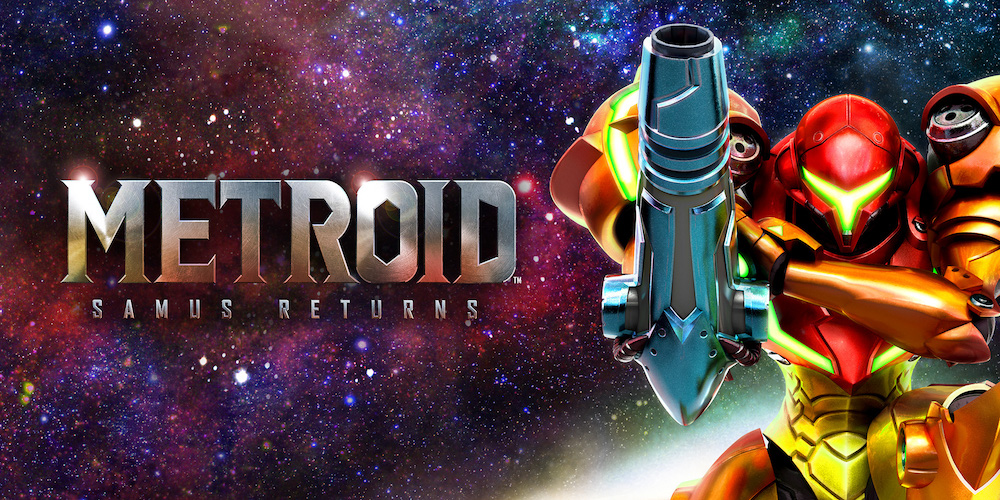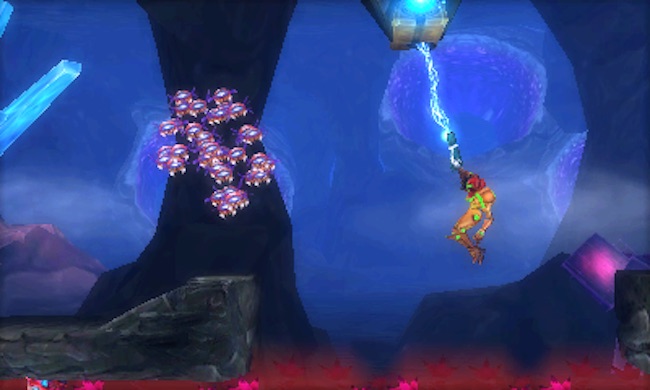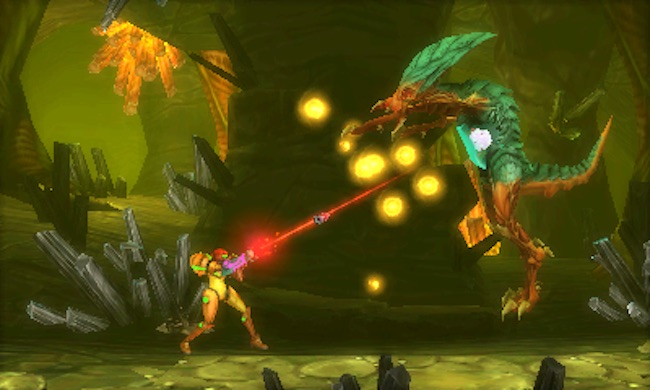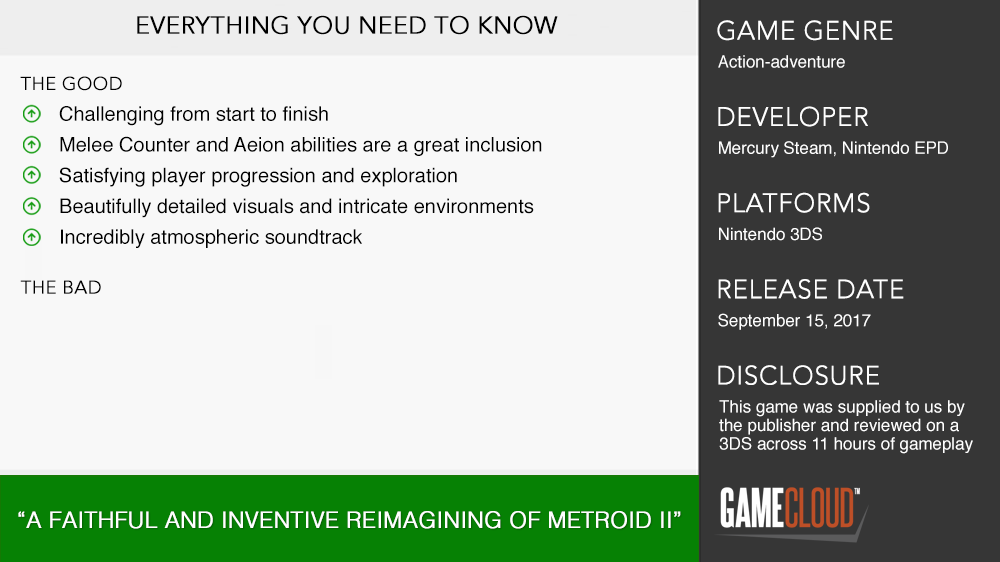
Seven years. It’s been seven long, gruelling, arduous years since a mainline Metroid game saw the light of day; the last of which being Metroid: Other M on the Wii. It wasn’t exactly well received by fans, and after the catastrophe that was 2016’s Federation Force, I was sure that E3 2017 would be the final nail in the coffin for Metroid. It’s been an even longer thirteen years since the release of the last classic 2D entry into the franchise, so it came as a pleasant surprise when a full reimagining of Metroid II: Return of Samus was announced for the 3DS. Developed collaboratively by Nintendo and MercurySteam, and produced by series veteran Yoshio Sakamoto, Metroid: Samus Returns is the triumphant harken back to the glory days of 2D Metroid I was hoping for, comfortably settling as one of the best 3DS games to be released for the system in the process.

The one part of Samus Returns that stays entirely true to the original is its story and premise. It’s as simple here as it was back then. You play as Samus Aran, a bounty hunter who has been hired to eradicate a deadly alien race called the Metroid from their home planet, SR388. There’s a small summary of what’s going on at the beginning of the game, but that’s all you get until the end. All the rest of the plot is present in collectable Chozo Memories and environmental storytelling.
Traditionally, Samus doesn’t speak a single word throughout the game, but MercurySteam has absolutely nailed her as a character. All of her mannerisms, actions, and quirks are here in full form, and it had me smiling like an idiot on multiple occasions. Everything about her is captured perfectly, and it’s truly a treat to see her brought to life again, especially if you’re a fan of the franchise.
If you’ve played a 2D Metroid game before, you’ll feel right at home here. It stays relatively faithful to the old style games such as Fusion and Zero Mission, with some more quality of life improvements and new mechanics that change up the fundamentals of gameplay. The game will have you scour an area for Metroid to hunt down, and in the process, you’ll find different types of doors, indestructible blocks, and ledges you can’t reach. That’s where exploration comes in. You’ll be consistently searching environments for new power-ups and abilities to tackle these new obstacles, find Metroid, and progress further.

Samus Returns adheres to the structure established by Metroid games past and never shies away from it as you explore a fallen Chozo empire. While Samus can employ numerous tools while you traverse through SR388, it’s almost imperative that you search for additional missile and energy tanks because this reimagining is very difficult. The primary form of the challenge comes in the form of the various Metroid types you’ll hunt. They start off fairly straightforward with heavily telegraphed attacks, but eventually, they start evolving, adapting elements and using new tactics. They’re always interesting encounters that challenge the skills you’ve accumulated, alongside Samus’s newfound abilities.
One of the biggest innovations to Samus Returns is the inclusion of the Melee Counter. The Melee Counter is exactly what it sounds like: Samus swipes her arm cannon up, destroying any projectiles and stunning any enemy who tries to attack you. It instantly charges her next beam shot, too, allowing for a quick yet deadly response that swiftly ends anything unlucky enough to get caught in the hitbox. Some enemies such as Metroid have more cinematic counter animations that see Samus exercising her acrobatic abilities. They look great in motion and act as a strong incentive to play patiently and use the counter in smart ways.

The other significant change to this reimagining is the inclusion of Aeion Abilities. There are four to be collected over the course of the game, each one with their own unique use. The Scan Pulse, for example, shows nearby unexplored areas, item locations, and breakable blocks, while the Lightning Armor ability provides Samus with invulnerability and a larger Melee Counter as long as she has Aeion. Aeion is the resource used to power these abilities, and it limits how often you can use each one and in what situation. It creates a nice balance, and some abilities need to be used sparingly to progress through areas. While Aeion recharge stations and enemies act as a means to refill the energy, proper management of this resource is key to surviving.
Samus Return’s art style is hard to compare to any previous Metroid titles, simply because it’s the first mainline title on the system. It feels as if they took what they did with Zero Mission, but with 3D models, backgrounds and environments. That description probably doesn’t do it justice, but that doesn’t change the fact that Metroid: Samus Returns is one of the best looking games on the 3DS. Each of the different environments you explore are filled with bright colours, detailed backgrounds, and models for both Samus and enemies that look believable and intricate.
The one thing that was a given was that Metroid: Samus Returns would feature an excellent, atmospheric soundtrack that the series is known for, and it certainly delivers. I was grinning like an idiot when themes from older games started playing as I entered new areas, or when the various sound effects of picking up items and scrolling through menus went off. It’s a nostalgia-filled love letter to fans of the series, and it does an excellent job of immersing you into the world of SR388.

As a dedicated Metroid fan, it makes me so happy to praise this game for what it is. Samus Returns is a faithful reimagining that isn’t afraid to step out of its comfort zone to innovate and try new ideas, and it succeeds all the more because of it. The inclusion of the Melee Counter and Aeion Abilities ensure the experience remains fresh and provides you with the advantage you’ll need to get through this relentlessly hostile planet. Its player progression also keeps you hooked and coming back for more, and it really makes you feel like you’re getting better and stronger alongside Samus. SR388 is simply a joy to explore as you traverse through different environments, each intricately woven, detailed, and equally challenging. It all comes together with an incredible soundtrack that stops at nothing to drop you into this world head first – seriously, use headphones for this one. Samus Returns is the love letter Metroid fans have been waiting for, clearly showing that Nintendo can hear our cries and pleas for more of our favourite bounty hunter. Here’s hoping that Samus Returns is a good omen for what’s to come.











